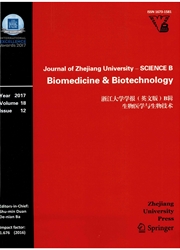

 中文摘要:
中文摘要:
有在在 Ca 的抑制之上的 vitro 的骨胳的肌肉的一条慢放松的尾巴[2+] 由 cyclopiazonic 酸(CPA ) 的泵。此处,从快放松的阶段解决这条慢放松的尾巴的一个新线性地联合的双性人指数的模型在 vitro 为 Bufo gastrocnemius 的等轴的松驰过程的运动分析被调查,与单身的指数的模型相比;古典双性人指数的模型。在在由在 12 V 直接货币(DC ) 的 2-ms 持续时间的方形的脉搏的 2-s 间隔的重复刺激期间, Bufo gastrocnemius 的等轴的紧张在 100 Hz 被记录。有在下刺激前从 90% 山峰掉到第 15 资料的紧张的松驰曲线被三个指数的模型在 MATLAB 6.5 用一个节目分析。两美德合适;为最好适合的剩余的分发为控制肌肉的松驰过程的运动分析支持了这个新双性人指数的模型的可比较的有效性。然而,在 CPA 治疗以后,这个新双性人指数的模型为肌肉松驰过程的运动分析显示出明显的统计优势,;它由试验给了对那一致的估计的休息紧张,而两古典双性人指数的模型;单身的指数的模型给了偏导的休息紧张。而且在由 CPA 的肌肉的处理以后,两单身的指数的模型;不过,古典双性人指数的模型产出降低的松驰率除了高得多的休息紧张,这个新双性人指数的模型有可以忽略的变化的松驰率。这些结果建议这个新奇线性地联合的双性人指数的模型为有改变的 Ca 的肌肉的松驰过程的运动分析是合乎需要的[2+] 抽活动。
 英文摘要:
英文摘要:
There was a slow-relaxing tail of skeletal muscles in vitro upon the inhibition of Ca^2+-pump by cyclopiazonic acid (CPA). Herein, a new linearly-combined bi-exponential model to resolve this slow-relaxing tail from the fast-relaxing phase was investigated for kinetic analysis of the isometric relaxation process of Bufo gastrocnemius in vitro, in comparison to the single exponential model and the classical bi-exponential model. During repetitive stimulations at a 2-s interval by square pulses of a 2-ms duration at 12 V direct currency (DC), the isometric tension of Bufo gastrocnemius was recorded at 100 Hz. The relaxation curve with tensions falling from 90% of the peak to the 15th datum before next stimulation was analyzed by three exponential models using a program in MATLAB 6.5. Both the goodness of fit and the distribution of the residuals for the best fitting supported the comparable validity of this new bi-exponential model for kinetic analysis of the relaxation process of the control muscles. After CPA treatment, however, this new bi-exponential model showed an obvious statistical superiority for kinetic analysis of the muscle relaxation process, and it gave the estimated rest tension consistent to that by experimentation, whereas both the classical bi-exponential model and the single exponential model gave biased rest tensions. Moreover, after the treatment of muscles by CPA, both the single exponential model and the classical bi-exponential model yielded lowered relaxation rates, nevertheless, this new bi-exponential model had relaxation rates of negligible changes except much higher rest tensions. These results suggest that this novel linearly-combined bi-exponential model is desirable for kinetic analysis of the relaxation process of muscles with altered Ca2^+-pumping activity.
 同期刊论文项目
同期刊论文项目
 同项目期刊论文
同项目期刊论文
 期刊信息
期刊信息
